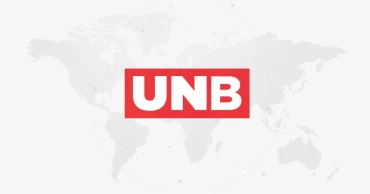AQI Index
Dhaka air quality ‘unhealthy’ Tuesday morning
Dhaka air was classified as “Unhealthy” on Tuesday morning.
The city has ranked sisth on the list of cities with the worst air quality with an AQI score of 166 at 9: 46 am, according to the air quality index.
India’s Delhi, Pakistan’s Lahore and United Arab Emirates’ Dubai occupied the first, second, and third spots on the list, with AQI scores of 187, 179 and 174’ respectively.
Dhaka’s air quality ‘unhealthy’ this morning
When the AQI value for particle pollution is between 50 and 100, air quality is considered ‘moderate’, usually sensitive individuals should consider limiting prolonged outdoor exertion, between 101 and 150, air quality is considered ‘unhealthy for sensitive groups’, between 150 and 200 is ‘unhealthy’, between 201 and 300 is said to be 'very unhealthy', while a reading of 301+ is considered 'hazardous', posing serious health risks to residents.
The AQI, an index for reporting daily air quality, informs people how clean or polluted the air of a certain city is and what associated health effects might be a concern for them.
The AQI in Bangladesh is based on five pollutants: particulate matter (PM10 and PM2.5), NO2, CO, SO2, and ozone.
Dhaka has long been grappling with air pollution issues. Its air quality usually turns unhealthy in winter and improves during the monsoon.
Dhaka’s air quality ‘unhealthy’ this morning
As per World Health Organization (WHO), air pollution kills an estimated seven million people worldwide every year, mainly due to increased mortality from stroke, heart disease, chronic obstructive pulmonary disease, lung cancer, and acute respiratory infections.
9 months ago
Dhaka air ‘unhealthy for sensitive groups’ Sunday morning
Dhaka has ranked the 15th on the list of cities with the worst air quality with an AQI score of 128 at 8:27 am on Sunday morning.
The air was classified as “unhealthy for sensitive groups”, referring to a health risk to residents, according to the AQI index.
Dhaka’s air quality ‘unhealthy’ this morning
Thailand’s Chiang Mai, Qatar’s Doha and Azerbaijan’s Baku occupied the first, second, and third spots on the list, respectively with AQI scores of 171, 162 and 160, respectively.
When the AQI value for particle pollution is between 50 and 100, air quality is considered ‘moderate’, usually sensitive individuals should consider limiting prolonged outdoor exertion, between 101 and 150, air quality is considered ‘unhealthy for sensitive groups’, between 150 and 200 is ‘unhealthy’, between 201 and 300 is said to be 'very unhealthy', while a reading of 301+ is considered 'hazardous', posing serious health risks to residents.
The AQI, an index for reporting daily air quality, informs people how clean or polluted the air of a certain city is and what associated health effects might be a concern for them.
The AQI in Bangladesh is based on five pollutants: particulate matter (PM10 and PM2.5), NO2, CO, SO2, and ozone.
Dhaka has long been grappling with air pollution issues. Its air quality usually turns unhealthy in winter and improves during the monsoon.
Dhaka’s air quality ‘unhealthy’ this morning
As per World Health Organization (WHO), air pollution kills an estimated seven million people worldwide every year, mainly due to increased mortality from stroke, heart disease, chronic obstructive pulmonary disease, lung cancer, and acute respiratory infections.
9 months ago
Dhaka’s air ‘unhealthy’ on Monday morning
Dhaka, the densely populated capital of Bangladesh, ranked tenth among the cities with the worst air quality, with an AQI score of 163 at 9:15am on Monday morning.
The air was classified as 'unhealthy’, referring to a health threat to residents, according to the AQI index.
When the AQI value for particle pollution is between 50 and 100, air quality is considered ‘moderate’, usually sensitive individuals should consider limiting prolonged outdoor exertion, between 101 and 150, air quality is considered ‘unhealthy for sensitive groups’, between 150 and 200 is ‘unhealthy’, between 201 and 300 is said to be 'very unhealthy', while a reading of 301+ is considered 'hazardous', posing serious health risks to residents.
Adviser Rizwana urges students to join in reducing noise, plastic pollution
Mongolia’s Ulaanbaatar, India’s Delhi, and Sarajevo of Bosnia Herzegovina occupied first, second and third spots on the list, with AQI scores of 223, 214 and 204, respectively.
The AQI, an index for reporting daily air quality, informs people how clean or polluted the air of a certain city is and what associated health effects might be a concern for them.
The AQI in Bangladesh is based on five pollutants: particulate matter (PM10 and PM2.5), NO2, CO, SO2, and ozone.
Dhaka has long been grappling with air pollution issues. Its air quality usually turns unhealthy in winter and improves during the monsoon.
How Green Industries Can Reduce River Water Pollution in Dhaka City
As per World Health Organization (WHO), air pollution kills an estimated seven million people worldwide every year, mainly due to increased mortality from stroke, heart disease, chronic obstructive pulmonary disease, lung cancer, and acute respiratory infections.
10 months ago
Dhaka’s air quality worst Tuesday morning
Dhaka has topped the list of cities with the worst air quality with an AQI score of 251 at 8:21 am on Tuesday morning.
The air quality was classified as “very unhealthy” according to the AQI Index.
Iraq’s Baghdad, Kyrgyzstan’s Bishkek and Democratic Republic of the Congo’s Kinshasa occupied the second, third and fourth spots on the list, with AQI scores of 248, 222 and 220, respectively.
Dhaka's air continues to be world's most polluted this morning
When the AQI value for particle pollution is between 50 and 100, air quality is considered ‘moderate’, usually sensitive individuals should consider limiting prolonged outdoor exertion, between 101 and 150, air quality is considered ‘unhealthy for sensitive groups’, between 150 and 200 is ‘unhealthy’, between 201 and 300 is said to be 'very unhealthy', while a reading of 301+ is considered 'hazardous', posing serious health risks to residents.
The AQI in Bangladesh is based on five pollutants: particulate matter (PM10 and PM2.5), NO2, CO, SO2, and ozone.
Dhaka's air ‘very unhealthy’ on Monday morning
Dhaka has long been grappling with air pollution issues. Its air quality usually turns unhealthy in winter and improves during the monsoon.
As per World Health Organization (WHO), air pollution kills an estimated seven million people worldwide every year, mainly due to increased mortality from stroke, heart disease, chronic obstructive pulmonary disease, lung cancer, and acute respiratory infections.
Dhaka's air quality 2nd worst in the world this morning
10 months ago
Dhaka’s air quality 'unhealthy for sensitive groups' this morning
Dhaka's air quality was categorised as “unhealthy for sensitive groups” this morning.
With an air quality index (AQI) score of 139 at 10:09 am am, Dhaka ranked fifth on the list of cities worldwide with the worst air quality.
Pakistan’s Lahore, India’s Delhi and Pakistan’s Karachi, occupied the first three spots on the list, with AQI scores of 524, 442 and 153 respectively.
Dhaka air ‘unhealthy’ this morning
When the AQI value for particle pollution is between 101 and 150, air quality is considered ‘unhealthy for sensitive groups’, between 150 and 200 is ‘unhealthy’, between 201 and 300 is said to be 'very unhealthy', while a reading of 301+ is considered 'hazardous', posing serious health risks to residents.
The AQI, an index for reporting daily air quality, informs people how clean or polluted the air of a certain city is and what associated health effects might be a concern for them.
The AQI in Bangladesh is based on five pollutants: particulate matter (PM10 and PM2.5), NO2, CO, SO2, and ozone.
Dhaka has long been grappling with air pollution issues. Its air quality usually turns unhealthy in winter and improves during the monsoon.
As per World Health Organization (WHO), air pollution kills an estimated seven million people worldwide every year, mainly due to increased mortality from stroke, heart disease, chronic obstructive pulmonary disease, lung cancer, and acute respiratory infections.
1 year ago
No improvement in Dhaka’s air quality, still ‘unhealthy’
Dhaka's air quality continued to be in the 'unhealthy' zone on Tuesday morning.
With an air quality index (AQI) score of 157 at 10 am, Dhaka ranked seventh in the list of cities around the world with the worst air quality.
An AQI between 101 and 200 is considered 'unhealthy', particularly for sensitive groups.
Pakistan’s Lahore, India’s Delhi and Pakistan’s Karachi occupied the first three spots in the list, with AQI scores of 457, 341 and 203, respectively.
Read more: Dhaka's air quality 'unhealthy' this morning
An AQI between 201 and 300 is said to be 'poor', while a reading of 301 to 400 is considered 'hazardous', posing serious health risks to residents. In Bangladesh, the AQI score is based on five kinds of pollutants — particulate matter (PM10 and PM2.5), NO2, CO, SO2 and Ozone.
Dhaka has long been grappling with air pollution issues. Its air quality usually turns unhealthy in winter and improves during the monsoon.
Read more: AQI: Dhaka’s air still ‘unhealthy’
Air pollution consistently ranks among the top risk factors for death and disability worldwide. Breathing polluted air has long been recognised as increasing a person’s chances of developing a heart disease, chronic respiratory diseases, lung infections and cancer, according to several studies.
As per the World Health Organization (WHO), air pollution kills an estimated seven million people worldwide every year, largely as a result of increased mortality from stroke, heart disease, chronic obstructive pulmonary disease, lung cancer and acute respiratory infections.
3 years ago
No improvement in Dhaka’s ‘unhealthy’ air this morning
Dhaka's air quality showed no improvement Friday morning as it continued to be in the 'unhealthy' zone.
With an air quality index (AQI) score of 166 at 9 am, the metropolis ranked sixth in the list of world cities with the worst air quality.
An AQI between 101 and 200 is considered 'unhealthy', particularly for sensitive groups.
Read more: Dhaka’s air ‘unhealthy’ this morning
With the advent of winter, the city’s air quality starts deteriorating sharply due to the massive discharge of pollutant particles from construction works, rundown roads, brick kilns and other sources.
Pakistan’s Lahore, India’s Delhi, and China’s Wuhan occupied the first three spots in the list, with AQI scores of382, 373 and 178, respectively.
An AQI between 201 and 300 is said to be 'poor', while a reading of 301 to 400 is considered 'hazardous', posing serious health risks to residents.
In Bangladesh, the AQI is based on five criteria pollutants -- Particulate Matter (PM10 and PM2.5), NO2, CO, SO2 and Ozone.
Read more: Dhaka’s air ‘unhealthy’ this morning as winter approaches
Dhaka has long been grappling with air pollution issues. Its air quality usually turns unhealthy in winter and improves during the monsoon.
Air pollution consistently ranks among the top risk factors for death and disability worldwide. Breathing polluted air has long been recognised as increasing a person’s chances of developing a heart disease, chronic respiratory diseases, lung infections and cancer, according to several studies.
As per the World Health Organization (WHO), air pollution kills an estimated seven million people worldwide every year, largely as a result of increased mortality from stroke, heart disease, chronic obstructive pulmonary disease, lung cancer and acute respiratory infections.
3 years ago
Dhaka’s air quality turns ‘unhealthy’
Dhaka's air quality on Tuesday slipped into the 'unhealthy' zone on Tuesday morning, despite heavy late monsoon showers a day before.
With an air quality index (AQI) score of 161 at 9 am, the metropolis ranked third in the list of world cities with the worst air quality.
Pakistan’s Lahore and Kuwait’s Kuwait City occupied the first two spots in the list, with AQI scores of 178 and 163, respectively.
An AQI between 101 and 200 is considered 'unhealthy', particularly for sensitive groups.
Also read: Dhaka’s air quality now ‘moderate'
On the other hand, an AQI between 50 and 100 is considered ‘moderate’ with an acceptable air quality. However, there may be a moderate health concern for a very small number of people who are unusually sensitive to air pollution.
Similarly, an AQI between 201 and 300 is said to be 'poor', while a reading of 301 to 400 is considered 'hazardous', posing serious health risks to residents.
AQI, an index for reporting daily air quality, is used by government agencies to inform people how clean or polluted the air of a certain city is, and what associated health effects might be a concern for them.
In Bangladesh, the AQI is based on five criteria pollutants -- Particulate Matter (PM10 and PM2.5), NO2, CO, SO2 and Ozone.
Dhaka has long been grappling with air pollution issues. Its air quality usually turns unhealthy during winter and improves during monsoon.
Also read: Dhaka’s air quality remains 'moderate'
With the advent of winter, the city’s air quality starts deteriorating sharply due to the massive discharge of pollutant particles from construction works, rundown roads, brick kilns and other sources.
Air pollution consistently ranks among the top risk factors for death and disability worldwide. Breathing polluted air has long been recognised as increasing a person’s chances of developing heart disease, chronic respiratory diseases, lung infections and cancer, according to several studies.
As per the World Health Organization (WHO), air pollution kills an estimated seven million people worldwide every year, largely as a result of increased mortality from stroke, heart disease, chronic obstructive pulmonary disease, lung cancer and acute respiratory infections.
3 years ago
Dhaka’s air quality remains ‘moderate’
Dhaka's air quality continues to be in the 'moderate' zone, all thanks to intermittent monsoon showers.
With an air quality index (AQI) score of 60 at 10.25 am, the densely populated metropolis on Tuesday ranked 27th in the list of world cities with the worst air quality.
An AQI between 50 and 100 is considered ‘moderate’ with an acceptable air quality. However, there may be a moderate health concern for a very small number of people who are unusually sensitive to air pollution.
Chile’s Santiago, Pakistan’s Lahore and Indonesia’s Jakarta occupied the first three spots in the list, with AQI scores of 184, 170, 155, respectively.
An AQI between 101 and 200 is considered 'unhealthy', particularly for sensitive groups.
Read:Dhaka’s air quality remains ‘moderate’
Similarly, an AQI between 201 and 300 is said to be 'poor', while a reading of 301 to 400 is considered 'hazardous', posing serious health risks to residents.
AQI, an index for reporting daily air quality, is used by government agencies to inform people how clean or polluted the air of a certain city is, and what associated health effects might be a concern for them.
In Bangladesh, the AQI is based on five criteria pollutants -- Particulate Matter (PM10 and PM2.5), NO2, CO, SO2 and Ozone.
Dhaka has long been grappling with air pollution issues. Its air quality usually turns unhealthy in winter and improves during the monsoon.
A report by the Department of Environment (DoE) and the World Bank in March 2019 pointed out that the three main sources of air pollution in Dhaka "are brick kilns, fumes from vehicles and dust from construction sites".
With the advent of winter, the city’s air quality starts deteriorating sharply due to the massive discharge of pollutant particles from construction work, rundown roads, brick kilns and other sources.
Air pollution consistently ranks among the top risk factors for death and disability worldwide. Breathing polluted air has long been recognised as increasing a person’s chances of developing a heart disease, chronic respiratory diseases, lung infections and cancer, according to several studies.
As per the World Health Organization (WHO), air pollution kills an estimated seven million people worldwide every year, largely as a result of increased mortality from stroke, heart disease, chronic obstructive pulmonary disease, lung cancer and acute respiratory infections.
3 years ago
Dhaka is the most polluted city on Earth
Avoid outdoor activities. It's hazardous to breathe in Dhaka.
Yes, the densely populated capital of Bangladesh has once again topped the list of world cities with the worst air quality.
Dhaka's air quality index (AQI) was recorded at 316 at 10.46am on Friday, which is considered ‘hazardous’.
India’s Delhi and Kolkata occupied the second and third spots with AQI scores of 210 and 200 respectively, in the latest list.
Also readDhaka is world's most polluted city
An AQI above 300 is considered 'hazardous' for everyone and doctors advise people to avoid all outdoor activities.
AQI, an index for reporting daily air quality, is used by government agencies to inform people how clean or polluted the air of a certain city is, and what associated health effects might be a concern for them.
In Bangladesh, the AQI is based on five criteria pollutants -- Particulate Matter (PM10 and PM2.5), NO2, CO, SO2 and Ozone.
Dhaka’s air quality usually turns unhealthy during winter and improves during monsoon.
A report by the Department of Environment (DoE) and the World Bank in March 2019 pointed out that the three main sources of air pollution in Dhaka "are brick kilns, fumes from vehicles and dust from construction sites".
Also read: Dhaka's air quality is still 'unhealthy'
With the advent of winter, the city’s air quality starts deteriorating sharply due to the massive discharge of pollutant particles from construction works, rundown roads, brick kilns and other sources.
Air pollution consistently ranks among the top risk factors for death and disability worldwide. Breathing polluted air has long been recognised as increasing a person’s chances of developing heart disease, chronic respiratory diseases, lung infections and cancer, according to several studies.
As per the World Health Organization (WHO), air pollution kills an estimated seven million people worldwide every year, largely as a result of increased mortality from stroke, heart disease, chronic obstructive pulmonary disease, lung cancer and acute respiratory infections.
3 years ago

















